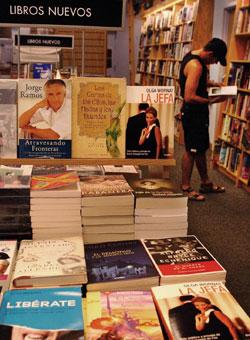|
 |
|
Esta página no está disponible en español. THE MIAMI HERALD Rewriting 'el libro' - At Times Literally BY CHRISTINA HOAG July 18, 2003
When La Jefa, by Olga Wornat, was published in May, the tell-all biography of the Mexican first lady Marta Sahagún sparked a huge controversy and huge sales in Mexico -- and a deluge of requests that sent staffers at U.S. bookstores scrambling. ''We had to work to get it; we had to go out to find it,'' said Aaron Feit, the Spanish-language buyer for the retailer Borders. ``But we got it. A few years ago, it would have been very difficult.'' Fueled by the rising tide of Latin American immigrants, the U.S. publishing industry has found a booming market in Spanish-language books, especially over the past two years: Major publishers like Random House and Harper Collins started their own Spanish-language imprints; the nation's biggest bookseller, Barnes & Noble, hired a full-time Spanish-language book buyer; and the trade journal Publishers Weekly launched the publication Críticas to track the burgeoning industry. Last fall, the Univisión morning talk show Despierta América introduced a monthly book segment hosted by news anchor Jorge Ramos, himself the author of two books. ''There has never been this kind of attention to this market,'' said Adriana López, editor of the two-year-old Críticas. ``It's gone from a glorified niche market to a parallel industry that exists beside the general market.'' To cater to the high interest among its members, the Association of American Publishers, which declared 2003 the Year of Latino Voices for America, has scheduled its first conference on the Hispanic market for November in New York City. Included will be workshops on such topics as translation. ''I expect very high attendance,'' said Kathryn Blough, the association's vice president. Sales numbers are hard to come by in the closed publishing world, but the number of titles available in Spanish has soared from 5,000 two years ago to more than 30,000 today, López said. Most are imported from Spanish and Latin American publishers, but a growing number of books in Spanish are being published by U.S. companies eager to give their titles new life in another language. ''Ten years ago, we would have to go through academic importers who were focused on classics; we could always get Cervantes, for example,'' said George Tattersfield, Spanish-language category manager for Borders, based in Ann Arbor, Mich. ``Now more and more places are coming to us with a much broader offering.'' Catalogs range from translations of Danielle Steele and John Grisham bestsellers to Louise Hay's self-help paperbacks to Latin literary heavyweights like Gabriel García Márquez and Mario Vargas Llosa. NEW CROP OF READERS The market, its traditional core composed of schools and libraries, is being propelled by a new crop of readers from Latin America, where lending libraries are rare and book buying is largely a luxury reserved for the elite. In the United States, books are much more accessible, be it through local libraries, relatively cheaper prices or store policies that encourage customers to leaf through books. And that's translating into expanding sales. Rayo, the imprint launched by Harper Collins two years ago to publish both Spanish-language and Hispanic-themed, English-language books, is already turning a profit, according to Editorial Director René Alegría, though he declined to give out figures. ''Sales have exceeded expectations,'' he said. ``We're actively seeking more titles.'' Lectorum Publications, the largest Spanish-language distributor in the United States, was bought by the publisher Scholastic in 1996 and has seen a 30 percent jump in its Spanish-language sales over the past half-decade, Lectorum President Teresa Mlawer said. ''It's a market that's going to continue to grow,'' she said. Foreign publishers, however, are hindering that growth somewhat through their inexperience in the competitive American book business. Overseas publishers tend to not accept the return of unsold books, spend little on promotion and have a limited marketing vision as to what books -- like La Jefa or those involving stories about other Latin American figures -- might appeal to the Hispanic American market. BEGGING FOR SAMPLES ''I'm always begging the foreign publishers for samples,'' Mlawer said. ``They don't understand that this is a very big country and you need to send samples. This is where U.S. publishers have the advantage.'' The learning curve, though, goes both ways: U.S. distributors have had to learn how to import books. ''They had no idea,'' López said. Children's books in Spanish are another key piece of the market, appealing as they do to both Hispanic parents and non-Hispanic parents eager to have their kids learn Spanish. And books in English by Hispanic American authors or about Hispanic themes are just now hitting their stride, Rayo's Alegría said. Some are even translated into Spanish. Industry insiders say they expect the market's expansion to continue along with the skyrocketing Hispanic American population. ''People are very enthusiastic and excited,'' López said. ``It's really taken off.''
|

 ----------
----------